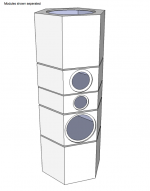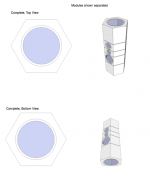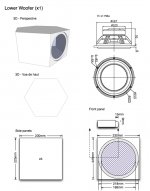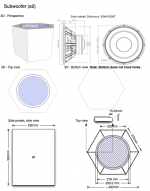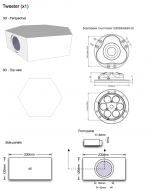Hello,
Before I go and buy MDF and drill in it, I'd like some honest objective/subjective criticism on this design just to make sure. Might even try glass for this; while the monster passed the WAF test it didn't exactly excel in it.
It's a 4 way with in the shape of a uniform hexagonal prism (I think that's what they're called). Attached are the plans in full details. This monster will be fully active (amps are working; yay. Crossover not so much). If I remember grade school the formula for calculating a hexagonal prism is V = 3ash. Bracing is not included in the plans but if glass is used then the less the better.
In my design, 'a' and 's' are constants at a = 231, s = 230.
Subwoofer
=====
Volume = 1.71115664 cubic feet
(There are 2 subs; this is more to balance the design)
Both subs are Scan-speak Discovery 30W/4558T low-pass at about 80Hz
Lower Woofer
=======
Volume = 1.26648106 cubic feet
Is a Hi-Vi M8a. I just happen to have one.
From 80Hz to ~850Hz
Upper Woofer
======
Volume = 0.872464733 cubic feet
Is a SEAS Excel W15CY-001.
850Hz to about 5kHz
Tweeter
=======
Volume = 0.675456567 cubic feet
5kHz to infinity, and beyond !
Many thanks in advance. Construction is not expected to start very soon as the budget is a bit tight for hobbies this time of year. If this does not turn out nice at least I'll learn from it.
Before I go and buy MDF and drill in it, I'd like some honest objective/subjective criticism on this design just to make sure. Might even try glass for this; while the monster passed the WAF test it didn't exactly excel in it.
It's a 4 way with in the shape of a uniform hexagonal prism (I think that's what they're called). Attached are the plans in full details. This monster will be fully active (amps are working; yay. Crossover not so much). If I remember grade school the formula for calculating a hexagonal prism is V = 3ash. Bracing is not included in the plans but if glass is used then the less the better.
In my design, 'a' and 's' are constants at a = 231, s = 230.
Subwoofer
=====
Volume = 1.71115664 cubic feet
(There are 2 subs; this is more to balance the design)
Both subs are Scan-speak Discovery 30W/4558T low-pass at about 80Hz
Lower Woofer
=======
Volume = 1.26648106 cubic feet
Is a Hi-Vi M8a. I just happen to have one.
From 80Hz to ~850Hz
Upper Woofer
======
Volume = 0.872464733 cubic feet
Is a SEAS Excel W15CY-001.
850Hz to about 5kHz
Tweeter
=======
Volume = 0.675456567 cubic feet
5kHz to infinity, and beyond !
Many thanks in advance. Construction is not expected to start very soon as the budget is a bit tight for hobbies this time of year. If this does not turn out nice at least I'll learn from it.
Attachments
Are those all seperate boxes? I like the looks of it. Is there president for all those drivers working together or are you going to work out the xover? Seems like it could be a very good looking speaker, but a lot of bits involved.
Hi,
it´ll be most definitely a hellot of work.
I wonder though about the choice of drivers and crossover-freqs.
Sorry to say, but I get the impression that You think, that buying a bunch of terribly pricey drivers will do the job. No, it ain´t so. If one´s a experienced or talented designer, one may really get the extras from out of those expensive stuff, but I´m afraid in more cases this simply does not happen and the end result remains just a bunch of overprized and overhyped stuff. Well, Yes it will certainly look expensive no doubt about that, but will it sound? As with any system the role of the crossover should not be underestimated. A well designed Xover driving into mediocre drivers certainly will sound superior to a mediocre X-over driving fine drivers.
If You don´t want to use digital filters I´d suggest to build a dedicated analog filter (with dedicated I mean filters that they are designed like passive filters, with the special drivers characteristics in mind and not as standard cookbook filters), preferrably using discrete devices and no OP-amps. You might rethink about the Xover frequencies. Especially the mid-high transistion at 5kHz seems a bit too high for my taste. I assume that the distribution character will show a break here. I´d rather opt for a bit lower frequency. Anyway this needs to be evaluated in praxis.
jauu
Calvin
it´ll be most definitely a hellot of work.
I wonder though about the choice of drivers and crossover-freqs.
Sorry to say, but I get the impression that You think, that buying a bunch of terribly pricey drivers will do the job. No, it ain´t so. If one´s a experienced or talented designer, one may really get the extras from out of those expensive stuff, but I´m afraid in more cases this simply does not happen and the end result remains just a bunch of overprized and overhyped stuff. Well, Yes it will certainly look expensive no doubt about that, but will it sound? As with any system the role of the crossover should not be underestimated. A well designed Xover driving into mediocre drivers certainly will sound superior to a mediocre X-over driving fine drivers.
If You don´t want to use digital filters I´d suggest to build a dedicated analog filter (with dedicated I mean filters that they are designed like passive filters, with the special drivers characteristics in mind and not as standard cookbook filters), preferrably using discrete devices and no OP-amps. You might rethink about the Xover frequencies. Especially the mid-high transistion at 5kHz seems a bit too high for my taste. I assume that the distribution character will show a break here. I´d rather opt for a bit lower frequency. Anyway this needs to be evaluated in praxis.
jauu
Calvin
Sounds like fun! 5 Khz for a Excel 5" magnesium might be a bit too high not only because the evil resonance peaks up in that area. Good luck!
But then again, designing something big and powerful is a lot more gratifying, isn't it?
Just don't underestimate the complexity of a speaker like this. What kind of crossover are you planning to use? Digital crossovers like a Behringer DCX can make your job a lot easier, but you still have to be able to do measurements and know how to interpret them.
If I were designing the system, I'd ditch the Hi-Vi and couple the Scanspeak (drool drool) to the Seas (still drooling) directly.
Just don't underestimate the complexity of a speaker like this. What kind of crossover are you planning to use? Digital crossovers like a Behringer DCX can make your job a lot easier, but you still have to be able to do measurements and know how to interpret them.
If I were designing the system, I'd ditch the Hi-Vi and couple the Scanspeak (drool drool) to the Seas (still drooling) directly.
I see some problems here indeed. The internal shape of your boxes is almost circular - its close to the worst possible shape when regarding internal standing waves. Should be avoided! Only a sphere would be worse than this.
Also as others have noted, 5 kHz is way too high for the 5" Excel magnesium. I suggest crossing it over well below 2 kHz for optimum results, or choose a (paper) midrange better suited for a high XO point.
And then - why a 5" and then an 8"? Why not simplify a bit, and run two 5" instead? Two 5" has the same cone area and output capacity as one 8". Running the midwoofers down to 80 Hz also seems a bit too low, I suggest 150-200 Hz.
Even with XO at 150-200 Hz, a passive XO network is going to be difficult to design, so either way an active XO is recommended.
Also as others have noted, 5 kHz is way too high for the 5" Excel magnesium. I suggest crossing it over well below 2 kHz for optimum results, or choose a (paper) midrange better suited for a high XO point.
And then - why a 5" and then an 8"? Why not simplify a bit, and run two 5" instead? Two 5" has the same cone area and output capacity as one 8". Running the midwoofers down to 80 Hz also seems a bit too low, I suggest 150-200 Hz.
Even with XO at 150-200 Hz, a passive XO network is going to be difficult to design, so either way an active XO is recommended.
Being at work I can't reply in deep details. For the drivers I already have them from other projects so I'd like to reuse them as the other attempts are now, let's just say full of holes.
As for crossing the Excel 5" magnesium so high, I did test it first and I can't say that it sounds bad; I'll give it another listen to night with some other music and try a movie. The XO is active and will either run on a FPGA or ARM7; having a bit of problems with the FPGA right now.
5" and then 8" is more for looks then anything else; maybe a SEAS Excel W22EX to keep the same look as with the 5". That would leave my M8a unused but the last thing I want to some other project that is not allowed in the living room without a divorce; listening to them in the workshop is nice but it's not where I'm most comfortable. And besides, I'd like to make something useful.
As for crossing the Excel 5" magnesium so high, I did test it first and I can't say that it sounds bad; I'll give it another listen to night with some other music and try a movie. The XO is active and will either run on a FPGA or ARM7; having a bit of problems with the FPGA right now.
5" and then 8" is more for looks then anything else; maybe a SEAS Excel W22EX to keep the same look as with the 5". That would leave my M8a unused but the last thing I want to some other project that is not allowed in the living room without a divorce; listening to them in the workshop is nice but it's not where I'm most comfortable. And besides, I'd like to make something useful.
I would be hesitant to mount drivers horizontaly as the cones do sag under gravity over time (years). I would recomend the FPGA as it should be able to impliment much higher order filters than the ARM7.
Hi,
If you want an honest opinion start from scratch again, and try and
understand what every engineering detail is trying to achieve. Active
is no shortcut whatsoever to getting it right, and usually unfortunately
an expedient that guarantees it will be wrong, its simply not that simple.
(e.g. hexagonal cabinets are a very bad idea, over e.g. six
sided but different face lengths, e.g. like the old Tannoys :

Dreadful speaker placement BTW, not the intended point of the shape.
rgds, sreten.
undefinition
Zaph|Audio
FRD Consortium tools guide
RJB Audio Projects
Speaker Design Works
HTGuide Forum - A Guide to HTguide.com Completed Speaker Designs.
Humble Homemade Hifi
Click below to go to
Quarter Wavelength Loudspeaker Design
The Frugal-Horns Site -- High Performance, Low Cost DIY Horn Designs
Linkwitz Lab - Loudspeaker Design
Music and Design
If you want an honest opinion start from scratch again, and try and
understand what every engineering detail is trying to achieve. Active
is no shortcut whatsoever to getting it right, and usually unfortunately
an expedient that guarantees it will be wrong, its simply not that simple.
(e.g. hexagonal cabinets are a very bad idea, over e.g. six
sided but different face lengths, e.g. like the old Tannoys :

Dreadful speaker placement BTW, not the intended point of the shape.
rgds, sreten.
undefinition
Zaph|Audio
FRD Consortium tools guide
RJB Audio Projects
Speaker Design Works
HTGuide Forum - A Guide to HTguide.com Completed Speaker Designs.
Humble Homemade Hifi
Click below to go to
Quarter Wavelength Loudspeaker Design
The Frugal-Horns Site -- High Performance, Low Cost DIY Horn Designs
Linkwitz Lab - Loudspeaker Design
Music and Design
Hello Yoshy, I can't comment on the particular drivers and the x-over, but to run a bit with StigErik's comment, you might try a 5 sided enclosure, instead of the six sided. That way you get rid of the parallel walls in the vertical realm. By doing that you can reduce the standing wave potential in the cabinets.
Peace,
Dave
Peace,
Dave
re:'That way you get rid of the parallel walls in the vertical realm', yep, that's good, but the enclosure is still more or less like a pipe, which isn't, unless the long dimension is broken up somehow by internal bracing
Looking at the drivers, I'd be inclined to go for a 3 way, leaving out the HiVi, but they've all got resonant peaks that need to be dealt with... = a complex xover
I like the basic look.
You want a smaller volume than shown for the W15, so it won't be hard to have an inner chamber that is the volume the driver sees and the rest of the space just making the outside shape work. You can make the inner chamber a trapezoid to minimize reflections. I don't think it will be much of an issue with the 12" or 8" driver's chambers as their operating range makes the wavelengths too long to resonate.
I'll also add my vote to making it a three way with a <2KHz crossover. Your tweeter can handle it, and you avoid the breakup modes of the W15 without a brick wall filter. You may be happy with crossing it at 5KHz, but I think long term that you'll be happier crossing lower. Notice the off axis response starts drooping at 2 KHz, indicating that you'll likely have a less than smooth power response crossing as high as you propose.
On the low end, crossed higher than 200 Hz, the W15 can get uncomfortably loud quite cleanly, even in my 22 x 30' room. It didn't do so well crossed at 80 Hz, so I say keep it a 4 way or bring the Scan woofers forward facing and make it a 3 way.
The Scans aren't really going to reach into subwoofer territory without a bunch of EQ unless your room is small and then you'd get into excursion trouble early.
You want a smaller volume than shown for the W15, so it won't be hard to have an inner chamber that is the volume the driver sees and the rest of the space just making the outside shape work. You can make the inner chamber a trapezoid to minimize reflections. I don't think it will be much of an issue with the 12" or 8" driver's chambers as their operating range makes the wavelengths too long to resonate.
I'll also add my vote to making it a three way with a <2KHz crossover. Your tweeter can handle it, and you avoid the breakup modes of the W15 without a brick wall filter. You may be happy with crossing it at 5KHz, but I think long term that you'll be happier crossing lower. Notice the off axis response starts drooping at 2 KHz, indicating that you'll likely have a less than smooth power response crossing as high as you propose.
On the low end, crossed higher than 200 Hz, the W15 can get uncomfortably loud quite cleanly, even in my 22 x 30' room. It didn't do so well crossed at 80 Hz, so I say keep it a 4 way or bring the Scan woofers forward facing and make it a 3 way.
The Scans aren't really going to reach into subwoofer territory without a bunch of EQ unless your room is small and then you'd get into excursion trouble early.
HA !
Woops, I'm sorry I just discovered a rather huge error. The sub are Peerless 835017 XXLS; not the 30w 🙂
Also the all drivers are separated in their own 'module' - top/bottom closed
Woops, I'm sorry I just discovered a rather huge error. The sub are Peerless 835017 XXLS; not the 30w 🙂
Also the all drivers are separated in their own 'module' - top/bottom closed
Last edited:
What active crossover will you will be using, ie, what slopes?
SEAS doesn't recommend a higher crossover than 3kHz for the mid but that is, probably, for passive.
In respect of the complexity, life is about learning, particularly if you do make a mistake. As someone once said, your mistakes are the only thing you can truly call your own.
But you do have experience with speakers, so go for it! A big adventure won't hurt.
Frank
SEAS doesn't recommend a higher crossover than 3kHz for the mid but that is, probably, for passive.
In respect of the complexity, life is about learning, particularly if you do make a mistake. As someone once said, your mistakes are the only thing you can truly call your own.
But you do have experience with speakers, so go for it! A big adventure won't hurt.
Frank
I'm currently testing the Excel 5" and the M8a as full-range drivers to give them a test listen with 5 tracks of the new Tron album.
I'll also cross them lower/higher and see what sounds better.
I'll also cross them lower/higher and see what sounds better.
The baffle step is going to be right in the middle of the range of the lower woofer. With that many drivers, surely you could put one of the crossover frequencies at the baffle step.
I read all the other responses from people far more experienced than I, and if it were my design, I would start over from scratch. Even if I had pallets of money to burn, I wouldn't want to spend all that time and effort on something that was not very likely to sound good.
I read all the other responses from people far more experienced than I, and if it were my design, I would start over from scratch. Even if I had pallets of money to burn, I wouldn't want to spend all that time and effort on something that was not very likely to sound good.
Hello Yoshy, I can't comment on the particular drivers and the x-over, but to run a bit with StigErik's comment, you might try a 5 sided enclosure, instead of the six sided. That way you get rid of the parallel walls in the vertical realm. By doing that you can reduce the standing wave potential in the cabinets.
Peace,
Dave
I was reading an acoustics book recently. The subject was rooms, not speaker enclosures, but boxes is boxes. It said that the popular wisdom about the desirability of non-parallel walls is wrong, and it had diagrams to prove it. It showed the standing-wave patterns in a studio that was built an odd shape in hopes of minimizing standing waves. The actual result was strong standing wave patterns that were shaped like the room. Duh! What does matter, it said, are the ratios of internal dimensions (incommensurate is better).
So, while reducing the number of sides from six to five might help a little, the traditional four would be even better, provided no two of the three dimensions were commensurate.
I think it's fair to say, six sides, all the same width, is just about as bad as possible.
Last edited:
Hi,
If you want an honest opinion start from scratch again, and try and
understand what every engineering detail is trying to achieve.
Since money would appear to be no object, start with a detailed specification of what is to be achieved, sonically and visually. Only then start the engineering. As it stands, the only spec we know of is that it must qualify for a WSA (Wife's Seal of Approval).
- Status
- Not open for further replies.
- Home
- Loudspeakers
- Multi-Way
- Honest opinion (peer review) about this 4Way before I build it
